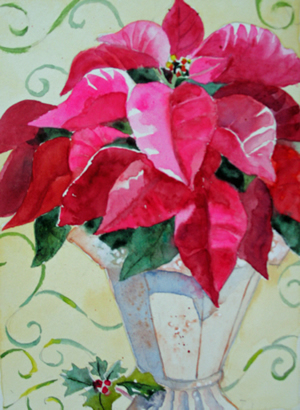
Our thanks to artist and friend, Lesta Frank, for this lovely print.
From Wikipedia: In Nahuatl, the language of the Aztecs, the plant is called Cuitlaxochitl (from cuitlatl=residue, and xochitl=flower) meaning “flower that grows in residues or soil.” The Aztecs used the plant to produce red dye and as an antipyretic medication. Today it is known in Mexico and Guatemala as “Noche Buena”, meaning Christmas Eve. In Spain it is known as “Flor de Pascua”, meaning Easter Flower. In both Chile and Peru, the plant became known as “Crown of the Andes”.
The plant’s association with Christmas began in 16th century Mexico, where legend tells of a young girl who was too poor to provide a gift for the celebration of Jesus’ birthday. The tale goes that the child was inspired by an angel to gather weeds from the roadside and place them in front of the church altar. Crimson “blossoms” sprouted from the weeds and became beautiful poinsettias. From the 17th century, Franciscan friars in Mexico included the plants in their Christmas celebrations. The star-shaped leaf pattern is said to symbolize the Star of Bethlehem, and the red color represents the blood sacrifice through the crucifixion of Jesus.
